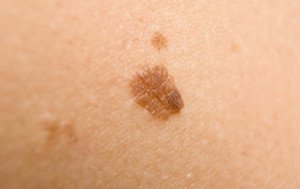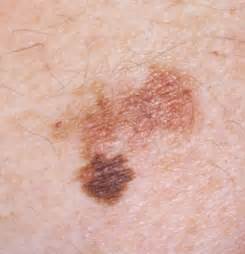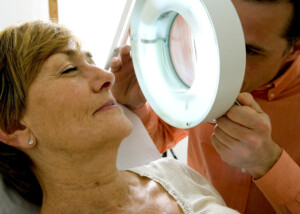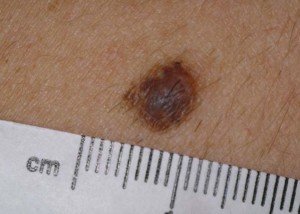
Age spot
Can a melanoma look like an age spot and vice versa?
As people get older, their risk of melanoma rises, but they also start developing age spots.
Age spots commonly appear on sun-exposed areas of the skin, such as the hands, face, shoulders and arms.
They are typically a result of prolonged sun exposure and are associated with aging.
Can the physical appearance of age spots and melanoma overlap each other?
“Age spots are linked to both aging and sun exposure,” says Dr. Michael Shapiro, MD, Medical Director and Founder of Vanguard Dermatology in NYC, NY.
“Also known as liver spots or solar lentigines, age spots are typically oval, flat and typically black, brown or grey.”
Can age spots ever develop into skin cancer?
Dr. Shapiro says, “It isn’t scientifically proven that age spots can become melanoma, but they are linked together due to the similarity of sun exposure.”
Physical Appearance Comparison
Dr. Shapiro explains, “Age spots differ from melanoma in that they are typically oval, flat and brown in color as opposed to the asymmetrical, discolored malignant spots.”

An extremely asymmetrical melanoma
“Malignant spots will also be itchy and may cause oozing or bleeding, while age spots don’t have that effect.”
It’s possible for a malignant tumor not to be itchy, however.
It’s also possible for an age or liver spot not to be oval, but a little asymmetrical.
But the asymmetry won’t be as pronounced as it often is in a melanoma lesion.
When someone develops multiple age spots over time, they look pretty much the same, though with varying size.

Clusters of age or liver spots. Shutterstock/Image Point Fr
Usually, a melanoma simply will not look right. It will stand out in appearance from any nearby benign lesions.
It will be the oddball, the funny, weird or ugly looking spot that doesn’t resemble the others.
That’s the one that should get your attention and get evaluated by a dermatologist.
Melanoma can be brown, black, tan, grey, red, pink and even flesh colored. It can even have blue, shades of maroon and even white in it.
And in addition to being asymmetrical, this cancer often presents with jagged or erratic edges, or more than one color in the lesion, such as both brown and grey.
Another suspicious sign is that some portions of it may be elevated.
Yet another alarming sign is part of the border “leaking” out (in appearance, not literally) into the surrounding skin.
 Dr. Shapiro is a board certified dermatologist and Mohs surgeon and has treated over 12,000 Mohs cases for skin cancer. He is widely published in peer-reviewed academic journals.
Dr. Shapiro is a board certified dermatologist and Mohs surgeon and has treated over 12,000 Mohs cases for skin cancer. He is widely published in peer-reviewed academic journals.
 Lorra Garrick has been covering medical, fitness and cybersecurity topics for many years, having written thousands of articles for print magazines and websites, including as a ghostwriter. She’s also a former ACE-certified personal trainer.
Lorra Garrick has been covering medical, fitness and cybersecurity topics for many years, having written thousands of articles for print magazines and websites, including as a ghostwriter. She’s also a former ACE-certified personal trainer.









































